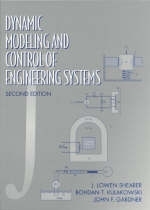
Dynamic Modeling and Control of Engineering Systems
Pearson (Verlag)
978-0-13-356403-7 (ISBN)
- Titel erscheint in neuer Auflage
- Artikel merken
Appropriate for upper level undergraduate or first-year graduate course in modeling of dynamic systems. May also be used in a first course in automatic control systems (assuming no background in modeling).
This book is a comprehensive treatment of the analysis of lumped parameter physical systems. The first portion of the book deals with the fundamentals of dynamics system modeling including a discussion of mechanical systems (translational and rotational), analytical solutions of ordinary differential equations and a discussion of state space theory. A greatly expanded treatment of numerical methods and techniques for computer simulation is also included. The nest portion of the text deals with modeling systems from various physical domains (electrical, fluid, and thermal) and systems which combine many physical domains. The book concludes with an introduction to the concepts and theory pertinent to automatic control systems, including computer control systems.
1. Introduction.
Systems and system models. System elements, their characteristics, and the role of integration. Linearization. Synopsis. Problems.
2. Mechanical Systems.
Introduction. Translational mechanical systems. Rotational mechanical systems. Simulation block diagrams. Synopsis. Problems.
3. Mathematical Models.
Introduction. Input-output models. State models. Transition between input-output and state models. Nonlinearities in input-output and state models. Synopsis. Problems.
4. Analytical Solutions of System Input-Output Equations.
Introduction. Analytical solutions of linear differential equations. First order models. Second order models. Third- and higher- order models. Synopsis. Problems.
5. Numerical Methods for the Solution of Ordinary Differential Equations.
Introduction. Euler's method. More accurate methods. Integration step size. Systems of differential equations. Synopsis. Problems.
6. Simulation of Dynamic Systems.
Introduction. Block diagram-oriented packages. Building a simulation. Studying a system with a simulation. Simulation case study: mechanical snubber. Synopsis. Problems.
7. Electrical Systems.
Introduction. Diagrams, symbols, and circuit laws. Elemental diagrams, equations, and energy storage. Analysis of systems of interacting electrical elements. Linear time-varying electrical elements. Synopsis. Problems.
8. Thermal Systems.
Introduction. Basic mechanisms of heat transfer. Lumped models of thermal systems. Synopsis. Problems.
9. Fluid Systems.
Introduction. Fluid system elements. Analysis of fluid systems. Pneumatic systems. Synopsis. Problems.
10. Mixed Systems.
Introduction. Energy-converting transducers and devices. Signal-converting transducers. Application examples. Synopsis. Problems.
11. System Transfer Functions.
Introduction. Examples of exponential inputs. System response to an exponential input. Use of block diagrams in system modeling. Transfer functions and performance characteristics. Synopsis. Problems.
12. Frequency Analysis.
Introduction. Frequency response transfer functions. Bode diagrams. Polar plot diagrams. Synopsis. Problems.
13. Closed-Loop Systems and System Stability.
Introduction. Basic definitions and terminology. Algebraic stability criteria. Nyquist stability criteria. Quantitative measures of stability. Root locus method. Synopsis. Problems.
14. Control Systems.
Introduction. Steady-state control error. Steady-state disturbance sensitivity. Interrelation of steady-state and transient considerations. Industrial controllers. System compensation. Synopsis. Problems.
15. Analysis of discrete-time systems.
Introduction. Mathematical modeling. Sampling and holding devices. The z transform. Pulse transfer function. Synopsis. Problems.
16. Digital Control Systems.
Introduction. Single-loop control systems. Transient performance. Steady-state performance. Digital controllers. Synopsis. Problems.
Appendix 1: Fourier Series and the Fourier Transform.
Appendix 2: Laplace Transform.
Appendix 3: SIMULINK Tutorial.
Glossary.
Index.
| Erscheint lt. Verlag | 22.9.1997 |
|---|---|
| Sprache | englisch |
| Maße | 183 x 241 mm |
| Gewicht | 767 g |
| Themenwelt | Informatik ► Grafik / Design ► Digitale Bildverarbeitung |
| Mathematik / Informatik ► Informatik ► Theorie / Studium | |
| Mathematik / Informatik ► Mathematik ► Angewandte Mathematik | |
| ISBN-10 | 0-13-356403-7 / 0133564037 |
| ISBN-13 | 978-0-13-356403-7 / 9780133564037 |
| Zustand | Neuware |
| Haben Sie eine Frage zum Produkt? |
aus dem Bereich



